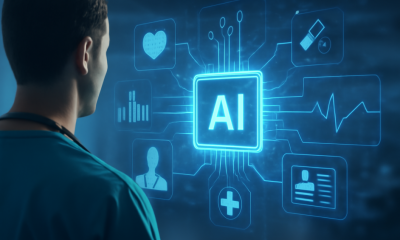Interviews
Anton Dolgikh, Head of AI, Healthcare and Life Sciences at DataArt – Interview Series

Anton Dolgikh leads AI and ML-oriented projects in the Healthcare and Life Sciences practice at DataArt and runs educational and training developers focused on solving business problems with ML methods. Prior to working at DataArt, Dolgikh worked in the Department of Complex Systems at the Université Libre de Bruxelles, a leading Belgian private research university.
What was it that originally inspired you to pursue AI and life sciences as a career?
A passion for searching the links between phenomena and facts. I always like to read. I love books. At university, I discovered a new source of information – articles. At some point, it appeared that to get a complete picture, to crystallize the beautiful truth from a mass of information is almost impossible. And here comes AI. Statistics, machine learning of course, and natural science with AI at the top all act to build the bridge between the human brain’s thirst for knowledge and a world where all the laws are known and there are no black boxes.
You currently educate and train developers who are focused on solving business problems with ML methods. Is there a specific field of machine learning that you focus on more, for example deep learning?
Yes, deep learning is a very popular and, let’s be honest, powerful instrument; we cannot neglect it. I personally prefer the Bayesian interpretation of classical algorithms, or even a combination of neural networks and a Bayesian approach — for example, a Bayesian Variational Autoencoder. But I believe that the most important thing to teach new ML guys is not to blindly use ML machinery like a magic black box, but rather perceive the basic principles behind each and every method. A must-have skill is the ability to explain the predictions obtained for a business audience.
In March 2019, you wrote an article called ‘Are we Ready for Machine Radiologists, and their Mistakes?'. In the article you outlined the pros and cons of accepting results from machine radiologists versus human radiologists. If you had to choose between a human and a machine giving you results, which would you choose and why?
I prefer a human radiologist. Not because I have some special knowledge that AI tis heavily prone to errors and decisions are intrinsically erroneous. No, it’s more a question of empathy and the psychological nature. I want to support human doctors during this difficult period. Moreover, I believe that in the nearest future, we will only see AI augment human ability.
You recently wrote a white paper called ‘The Impact of Artificial Intelligence on Lifespan.' In this paper, you stated that AI should be viewed as a tool in the search for longer life. What are some of the more promising methodologies that AI could apply to the quest to extend human lifespan?
Today the new tool of AI is beginning to operate in scientific laboratories on par with classical instruments and approaches. This fact itself is promising. AI is here to help, not replace, us in the struggle to cope with the huge quantities of data flooding not only laboratories but even our personal lives.
Also discussed in the same white paper is a claim by Biogerontology Research Foundation AI Director and CEO of Insilico Medicine, Dr Alex Zhavoronkov, that increasing lifespan to 150 years is not a fantastic goal. Do you believe that a child born in 2020 will be able to live to 120 or even 150 years?
I want to believe. Being a scientist by education and belief, I have to base my decisions on facts, on understanding the progress of scientific methods in the area. We’ve made an impressive leap in the fields of genetics, biotechnology and medicine in general, and this strengthens my belief. And don't forget that a substantial part of the success in increasing lifespan is a healthy environment and a healthy lifestyle, so we have to work on this.
In this same paper you mention the potential for mind uploading (transhumanism). Do you believe that this could eventually be a reality, and how does it make you feel personally?
I've thought a lot about it. Frankly, it makes me feel frustrated. I think that we associate personality with what we see in a mirror, and for me, it's hard to detach my character from my body. Nevertheless, this doesn't mean it is not possible. And, yes, I believe that sooner or later mind uploading will become feasible. The consequences are much harder to foresee.
You're currently the Head of AI, Healthcare and Life Sciences at DataArt. What are some of the most interesting projects DataArt is currently working on?
We have a project dedicated to new drug development. It's inspiring how computational methods have developed to fuel and direct the progress in medicinal chemistry and pharmacology. We also do a lot of work on applying AI to extract information from medical texts such as clinical trial reports, medical articles, and specialized forums. It's hard work, but it takes us closer to the digitalization of healthcare, and I find this exciting.
As an avid book lover, I also need to ask what books you recommend?
- Judea Pearl “Causality: Models, Reasoning and Inference“. The title is self-explanatory – the book is about causal relationships. If (one day) we want to have a true AI we have to teach it reasoning about the cause and effect;
- If you're interested in the causative and practical methods then the fundamental work of Daphne Koller and Nir Friedman “Probabilistic Graphical Models: Principles and Techniques” will be the right choice;
- We expect powerful AI to be able to understand us. Thus, we have to teach the language to it. Natural Language Processing tackles the problem of natural languages' comprehension. I have two titles in mind that helped me a lot:
- Yoav Goldberg, Neural Network Methods in Natural Language Processing (Synthesis Lectures on Human Language Technologies), 2017
- Christopher D. Manning, Prabhakar Raghavan, Hinrich Schütze An Introduction to Information Retrieval, 2009
- Not sure the next book is dedicated to AI, but it demonstrates a non-standard approach to statistics and predictions which will be useful for any AI researcher: Bertrand S. Clarke, Jennifer L. Clarke Predictive statistics: Analysis and Inference beyond models
- And I would end the list with a sci-fi book: Stanislav Lem, The Star Diaries
Is there anything else that you would like to share about DataArt?
DataArt is an excellent example of the recent trend toward digitalization of almost every aspect of life and activity. This trend increases responsibility in software development because today it's not only about building a site for a shop, for example, in which case a mistake by the developer will have minimal consequences. Today a developer's mistake could become a national or worldwide catastrophe if it involves a program controlling the functioning of, for example, a nuclear plant. DataArt's responsible approach to software development in a broad sense gives me confidence in what we develop, and I am very proud to be part of the company and the work that we are doing.
As for another recent project of hours, last year DataArt launched a prototype application called ‘SkinCareAI’, which analyses skin images to detect early signs of melanoma. Featuring the latest advancements in machine learning (ML) technology, SkinCareAI was developed by DataArt ML expert Andrey Sorokin for the International Skin Imaging Collaboration (ISIC) challenge.
To learn more about some of our other projects and case studies, please go to DataArt’s Healthcare and Life Sciences page.












